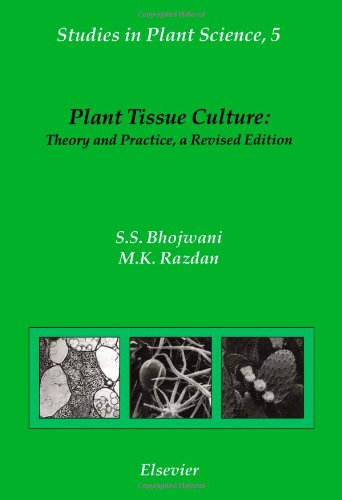
Plant Tissue Culture: 5 Books To Get You Started
As a content and community manager, I leverage my expertise in plant biotechnology, passion for tissue culture, and writing skills to create compelling articles, simplifying intricate scientific concepts, and address your inquiries. As a dedicated science communicator, I strive to spark curiosity and foster a love for science in my audience.


In this article, we will talk about 5 books that provide you with all the basic to advanced information on tissue culture. You can either choose one or read them all to strengthen your tissue culture knowledge.
Introduction
Tissue culture is a technique used to grow plants under in vitro or lab conditions. The technique uses a few tissues or single plant cells to develop them into a whole plant. It utilizes the totipotent property of the plants, where each plant cell has the ability to transform and form any plant cell.
It’s an advanced technique that requires basic knowledge to perform the procedure. One needs to have basic knowledge about chemicals, performing procedures, choosing plants, sterilizing them, transferring plant tissue to the media, understanding plant conditions during the cultivation process, understanding transformation at each stage, and transplanting them to the acclimation stage.
It’s a lot. And, there is very little information available on the internet to make you an expert in the area.
Though we have been creating blogs and Youtube videos only for tissue culturists like you, who can learn and use the knowledge to start their own tissue culture setup.
But, if you are really serious about your hitting into the tissue culture field, then an organized basic knowledge about tissue culture is what you require.
However, for this, you should have basic knowledge of plants, cells, tissues, and plant hormones. Or, in short, the basic biology of plants and certain chemicals.
In this article, we will talk about 5 books that provide you with all the basic to advanced information on tissue culture. You can either choose one or read them all to strengthen your tissue culture knowledge.
But, you may ask, do we really need books? Can’t it be easier and break into pieces by us to understand them better.
So, let me tell you I have already been creating many articles on the basic concepts of tissue culture. However, if there’s anything that you think can be more simplified and you want to learn more about it. Please let me know on the given email ID shared at the end of the article.
So, let’s have a look at what books are best to establish the base for you on tissue culture.
1. Plants from Test Tubes: An Introduction to Micropropagation
Written by Lydiane Kyte, John Kleyn, and Holly Scoggins
The book contains wonderful clear images and illustrations related to different tissue culture concepts, work processes, or equipment and tools.
The book is mainly divided into two parts:
- Section 1: It contains the theory or the basics of tissue culture, such as the botanical basis for tissue culture, history, media ingredients and preparation, rooting, business, and plant biotechnology.
- Section 2: It contains media preparations and protocols of some selected plants, such as Actinidia deliciosa (Kiwi fruit), Anthurium andraeanum (Flamingo Flower), Hypoxis hemerocallidea (African potato), and Vitis Vinifera (Wine Grape).
If you are a beginner in the tissue culture area and want to test some plants in tissue culture. Then, these books can be proved resourceful for you. You can try out the plans and their procedures given in the book to practice tissue culture on your chosen desired plants.

Figure: The book cover of the fourth edition of Plants From Test Tubes: An Introduction to Micropropagation.
2. Plant Tissue Culture: Theory and Practice
Written by Sant S Bhojwani and M. K. Razdan.
The first edition of the book was published in 1983. But, since then many revisions have taken place to incorporate the discoveries and developed concepts. The book contains the basics of tissue culture, including theory, practicals, and some applied concepts in the area.
If you want to start learning from the zero of tissue culture, then this book is best to introduce you in the best way possible to the tissue culture technique. It is full of illustrations, figures, diagrams, and photos that help you better understand the concepts.
The book contains around nineteen chapters covering topics ranging from the history of tissue culture, media preparation, haploid production, Variant Selection, and protoplast isolation, to germplasm storage.

Figure: The book cover of the fifth edition of the Plant Tissue Culture: Theory and Practice.
3. Introduction to Plant Tissue Culture
Written by M. K. Razdan
Plant tissue culture has become an integral part of agriculture biotechnology. And, Introduction to Plant Tissue Culture is a book that talks about the advancements in basic techniques, clonal propagation, and haploid and triploid production. All the concepts are combined with diagrams and illustrations for a better understanding of the concept.
The book has five parts:
- Part I (Introduction and Techniques): The first part of the book covers the history of tissue culture, media preparation, and lab organization.
- Part II (Basic Aspects): The section talks about cell culture, cellular totipotency, and somatic embryogenesis.
- Part III (Applications to Plant Breeding): The sections cover all about haploid production, triploid production, zygotic embryo culture, somaclonal variation, and more.
- Part IV (Applications to Horticulture and Forestry): The sections contain chapters on clonal propagation and producing disease-free plants.
- Part V (General Applications): It covers all about industrial applications and germplasm conservation.

Figure: The book cover of the third edition of the Introduction to Plant Tissue Culture.
4. Plant Tissue Culture: Techniques and Experiments
Written by Roberta H. Smith
The book is suitable for students and teachers both as it contains experiments and concepts that can be easily executed in labs all year round. The book has step-by-step protocols to tissue culture a range of plants, complemented with many detailed line diagrams.
The book consists of around 15 chapters with some of them further containing sub-sections of different small concepts.
The book has everything on tissue culture, ranging from protoplast culture, cell suspension cultures, haploid techniques, primary metabolism, phytohormones and growth regulators, and applications of plant tissue culture systems.

Figure: The book cover of the third edition of the book Plant Tissue Culture: Techniques and Experiments.
5. Plant Cell Culture Protocols
By Victor M Loyola-Vargas (Editor), Neftali Ochoa-Alejo (Editor)
The book is a collection of the most frequently used techniques for plant cell and tissue culture. Many protocols mentioned in the book are used in many research programs and business projects.
It has methods ranging from general methodologies, such as culture induction, growth and viability evaluation, and contamination control, to such highly specialized techniques as chloroplast transformation involving the laborious process of protoplast isolation and culture.

Figure: The book cover of the fourth edition of the book Plant Cell Culture Protocols.
How is Plant Cell Technology Helping Culturists Worldwide In Their Tissue Culture Application?
Plant Cell Technology is helping tissue culturists worldwide by providing unique and world-class products and services that smoothen their process. It has MS media, agar, gellan gum, Plant Preservative Mixture (PPM), culture vessels, Biocoupler (TM), and masks in its store to facilitate your processes.
And, that’s not it! Plant Cell Technology also offers consultation services to culturists of all sizes that help to get instant solutions to your tissue culture problems.
So, visit plantcelltechnology.com today and learn more about our products and services and how they help you excel in your tissue culture processes.
Happy Culturing!!
Blog Categories
View by Level
Popular Blogs

6 Plant Tissue Culture Books to Keep Learning
Introduction Most of us are fans of books when it comes to learning a topic in detail and in a...
Read More
New Technical Agar Vs Supreme Agar
Introduction What’s the secret element that supports and holds plants in vitro? Not sure? It’s the solidifying agent. Solidifying agents...
Read MoreSubscribe to Our Newsletter







Join the conversation
Your email address will not be published. Required fields are marked